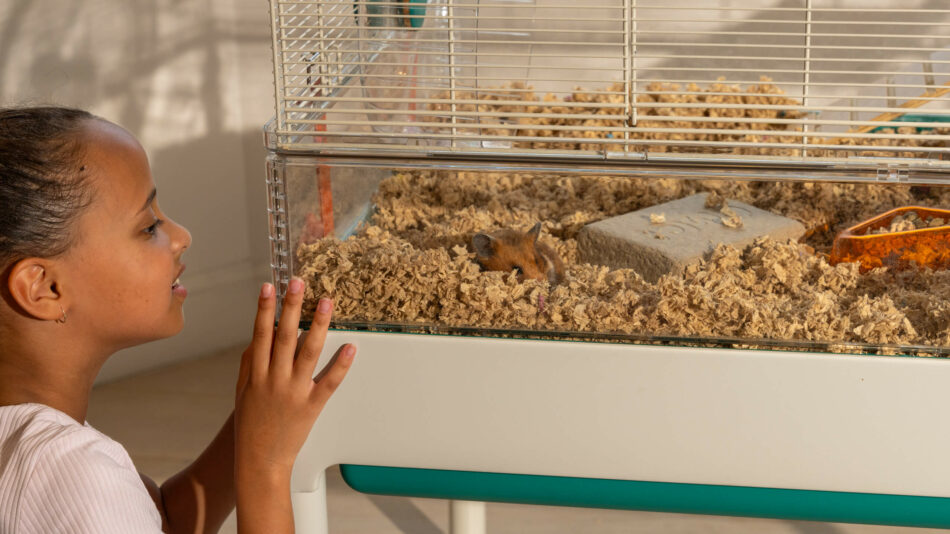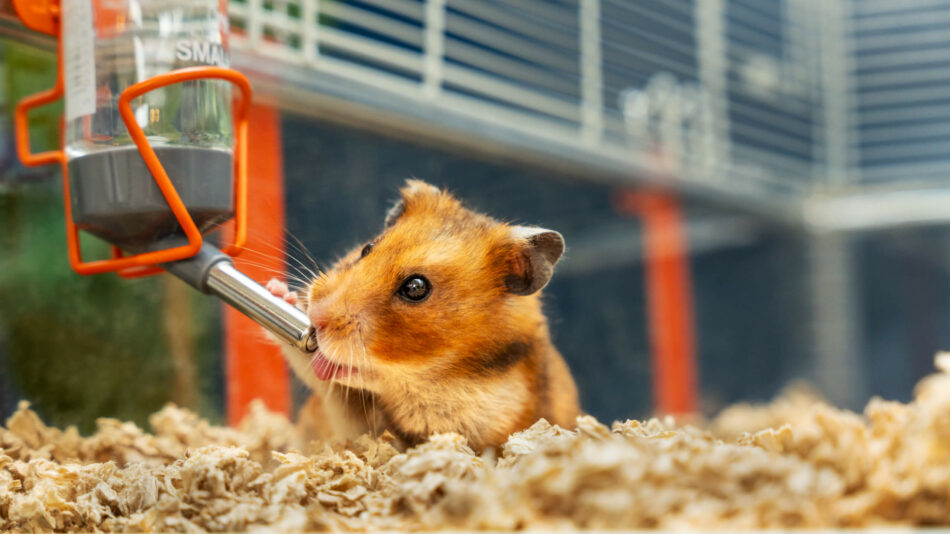A guide to a happy hamster
Looking for a guide to a happy hamster? You’re in luck — we’ve got everything you need to know about keeping your hamster happy and healthy. With these expert tips and tricks, your hamster will feel safe and supported from their first day in their new home, and for years to come.
What makes a hamster happy?
There are several things that affect how happy your hamster is. The crucial factors that impact hamster happiness are:
- Safety
- Comfort
- Nutrition
- Enrichment
Here’s an in depth look at each of these, and how to implement them in your hamster’s habitat.
Safety
As prey animals, hamsters are naturally on alert for potential dangers. If a hamster feels too exposed in their home, they’ll quickly become stressed in their surroundings. Having plenty of spaces for your hamster to find seclusion will help them feel safe in their home. Placing hamster hides around their habitat, and providing a deep layer of bedding for burrowing will help your small pet feel secure in their home.
Comfort
A hamster habitat should have a bedding tray deep enough to accommodate extensive burrowing, and should be large enough for your hamster to have dedicated sleep, eating, and toilet areas. Use comfortable bedding like recycled paper intended for small animals. This bedding is soft, absorbent, and dust-free, making it ideal for your hamster. Avoid using wood shavings, as these can cause respiratory issues in hamsters, as well as posing a risk of ingestion.
Nutrition
Hamsters are little animals, but they have big appetites. In fact, they’ll happily hoard stashes of food around their habitat to make sure they always have a snack on standby. You’ll notice your hamster stuffing their cheek pouches full of food to carry to their designated snacking station, so it’s important to give them the right nutrition to support their active bodies. Choose a quality hamster pellet rather than the “trail mix” variety that contains several different feed components. Offer seeds sparingly, as well as small pieces fresh fruits and vegetables. Treats like these should be offered no more than 2-3 times per week.
Enrichment
Your hamster will have a fast metabolism to go along with their hearty appetite. Since hamsters are nocturnal, they’ll sleep all day, but wake up during the evening hours with their voracious appetite — resulting in lots of energy to burn. Hamsters need a quality exercise wheel to run on to help keep their minds and bodies engaged, with some hamsters capable of running up to 5 miles in a single night. Along with their wheel, give your pet hamster tunnels or ramps and platforms to provide even more opportunity to exhibit natural behaviour patterns.
Bonding with your hamster
Hamsters are popular pets for children, but it is important to note that they are more instinct driven than other small pets. Their nocturnal nature makes daytime sleep schedules a necessity, and they can be more difficult to hand tame than other pets. But, with the right expectations in mind, they can be enjoyable pets for every member of the family.
To make sure your hamster gets the happiest start possible, give them at least 1 week to settle into their new home before attempting to interact with them. Talk to them while they’re awake to get them used to your voice, but don’t introduce physical contact until they’re fully settled. Once they seem comfortable and familiar with their new home, slowly begin introductions by placing your hand in their habitat and allowing them to sniff or climb on you. After a few days of this process, you can begin lifting them in your hand to get them familiar with being handled.
Once you’re able to handle your hamster, you’ll be able to transfer them to a hamster playpen for more playtime possibilities. Build mazes or obstacle courses for your hamster, or interact with them in an open environment for convenient and comfortable bonding time. Your hamster will soon learn to associate your presence with fun activities and gentle handling, building a bond that will last throughout your hamster’s life.
What to avoid to keep your hamster happy
To keep your hamster in a happy mindset, there are some things to avoid. Steer clear of these to preserve your hamster’s positive attitude and overall health.
Waking them during the day
Hamsters are nocturnal, and need their rest during the day. Waking a hamster in the middle of their sleep cycle is a sure way to make them grumpy, which could lead to them giving you a nip out of confusion or agitation.
Sudden movements or loud noises
Being prey animals, hamsters are easily startled. Avoid sudden movements and loud noises to lower your hamster’s stress. Opt for playtime in quiet rooms and move slowly when handling your hamster.
Fatty foods
Bread, pasta, sweets, and other processed foods aren’t good for hamsters. Stick to seeds, fresh fruits and vegetables, and unsweetened whole grain cereal as treats for your hamster.
Omlet and your hamster
The key to a happy hamster is a supportive home. Both the care you give them and their hamster habitat are essential in giving them a healthy and happy life. With our hamster products, you’ll provide your pet with everything they need to live their best lives. From hamster tunnels to hamster playpens, enjoy interacting with your pet and building a bond forged in happiness.
This entry was posted in Hamsters


